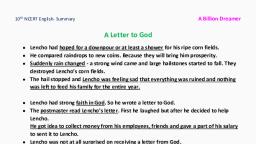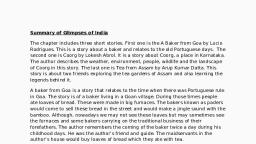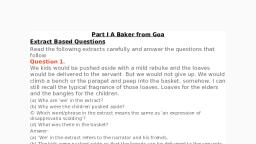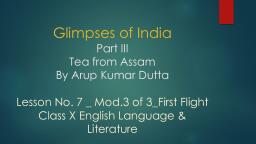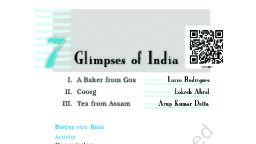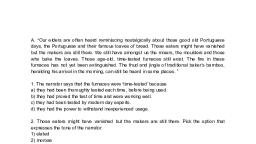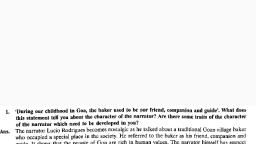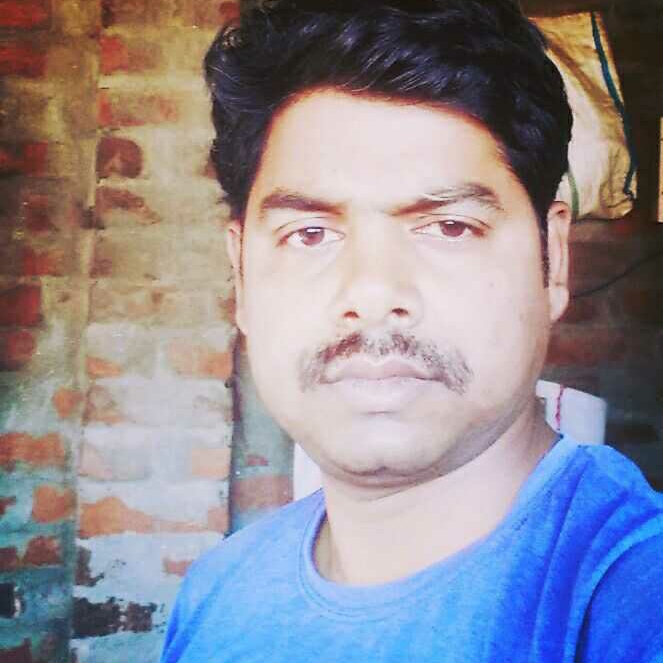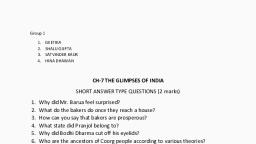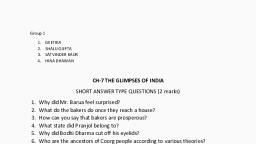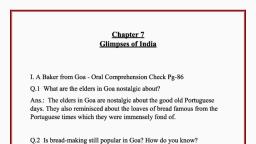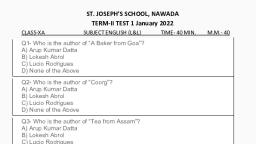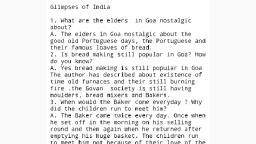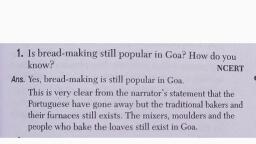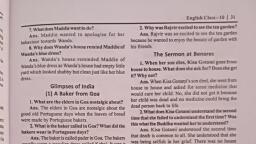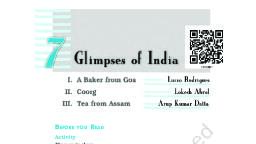Page 1 :
Glimpses of India, A Baker from Goa Introduction, ‘A Baker from Goa’ revolves around the relevance of a baker in the Goan culture which dates, back to the time when Portuguese ruled over the city of Goa. The Portuguese may have left but, the bread-makers continue to have an inevitable stature. In this story, the author recalls his, childhood days and their excitement on seeing the baker. They were enthusiastic to the point that, they would run to him as soon as they woke up without even brushing their teeth., , Glimpses of India A Baker from Goa Summary, The lesson begins with how narrator’s elders often recall the time when Goa was under the rule, of the Portuguese. They talk how the importance of bakers is still maintained in their villages, even after the Portuguese have left. They are known as ‘Paders’ in Goa. The mixers, moulders, and their time-tested furnaces continue to serve the people of Goa with their famous bread loaves., It is possible that the original ones may not exist, but their profession is being continued by their, sons. The thud of their bamboo stick can still be heard in some parts of the village. The same, jingling thud would wake the narrator and his friends during their childhood days who would go, running to him without brushing or washing their mouth properly. It was the maid-servant of the, house who collected the loaves while children sorted out the bread bangles for themselves., Bakery products have importance in the culture and traditions of Goa. Bol or sweet bread is a, part of marriage gifts, cakes and Bolinhas or coconut cookies are eaten at every festival and the, lady of the house prepares sandwiches at her daughter’s engagement. Earlier bakers wore a, unique frock of knee-length known as ‘kabai’ but during the narrator’s childhood days, they wore, a shirt and trousers of length slightly shorter than the usual ones. They generally collected their, bills at the end of every month. Bakery has continued to be a profitable profession, managing to, keep their families joyous and prosperous., , A Baker from Goa Lesson & Explanation, OUR elders are often heard reminiscing nostalgically about those good old Portuguese days, the, Portuguese and their famous loaves of bread. Those eaters of loaves might have vanished but the, makers are still there. We still have amongst us the mixers, the moulders and those who bake the, loaves. Those age-old, time-tested furnaces still exist. The fire in the furnaces has not yet been, extinguished. The thud and jingle of the traditional baker’s bamboo, heralding his arrival in the, morning, can still be heard in some places. Maybe the father is not alive but the son still carries, on the family profession. These bakers are, even today, known as pader in Goa., Reminiscing nostalgically- thinking fondly of the past, Loaves- (plural form of loaf) bread that is shaped and baked in a single piece and can be sliced, for eating, Vanished- disappear suddenly and completely, Moulders- a person who moulds dough into a shape, Furnaces- an enclosed structure in which materials can be heated to very high temperatures, Extinguished- cause a fire to cease to burn
Page 2 :
Heralding- announcing, Pader- word for baker in Portuguese language, The story takes us back to the time when Portuguese ruled Goa. They were immensely famous, for their breads. The narrator often finds his elders thinking about ‘those good old days’ and, telling them that the famous breads date back to the time when Portuguese ruled over Goa., They ponder over the past and tell them that though the Portuguese have left Goa but the, bakers of bread still exist, if not the original ones, their legacy is being continued by their sons., The bakers are still being referred to as ‘Paders’. Everything about baking is still the same;, ranging from those who mould the bread loaves, to the furnaces which have survived the, ravages of time. The sound of their arrival and the thud of their bamboo stick can still be heard, just like the olden times., , During our childhood in Goa, the baker used to be our friend, companion and guide. He used to, come at least twice a day. Once, when he set out in the morning on his selling round, and then, again, when he returned after emptying his huge basket. The jingling thud of his bamboo woke, us up from sleep and we ran to meet and greet him. Why was it so? Was it for the love of the, loaf? Not at all. The loaves were bought by some Paskine or Bastine, the maid-servant of the, house! What we longed for were those bread-bangles which we chose carefully. Sometimes it, was sweet bread of special make., Companion- a person with whom one spends a lot of time, Jingling- make or cause to make a light metallic ringing sound, The narrator recalls that the baker acted as their friend and companion during their childhood, days in Goa. The baker used to visit twice a day; once, while he was on the round to sell his, loaves and the other time, while returning back with his empty basket, having sold all the, loaves. It was the sound of his bamboo stick that woke the children up. The children were so, excited to meet him and choose from the bread bangles or Kankon he made especially for them., While the bangles were for children, loaves were for the adults that were generally collected by, the maid-servant of the household.
Page 3 :
The baker made his musical entry on the scene with the ‘jhang, jhang’ sound of his specially, made bamboo staff. One hand supported the basket on his head and the other banged the bamboo, on the ground. He would greet the lady of the house with “Good morning” and then place his, basket on the vertical bamboo. We kids would be pushed aside with a mild rebuke and the loaves, would be delivered to the servant. But we would not give up. We would climb a bench or the, parapet and peep into the basket, somehow. I can still recall the typical fragrance of those loaves., Loaves for the elders and the bangles for the children. Then we did not even care to brush our, teeth or wash our mouths properly. And why should we? Who would take the trouble of plucking, the mango-leaf for the toothbrush? And why was it necessary at all? The tiger never brushed his, teeth. Hot tea could wash and clean up everything so nicely, after all!, staff – stick, Rebuke- an expression of disapproval; a scolding, Fragrance- a pleasant, sweet smell, Parapet- railing, a low protective wall, bangles- here, refers to the bread in the shape of a bangle called ‘Kankon’, The baker often made a musical entry with his bamboo stick. His one hand supported the, basket on his head while the other banged the bamboo on the ground. He would go house to, house and greet the ladies before handing them over the loaves. The parents would scold the, children and make them stand aside. But as eager as they were, they would climb a bench or, the wall to peep into the basket. They did not even bother to brush their teeth before having, those bread bangles because it seemed an unnecessary effort for them to pluck mango leaves, from the branches to use them for brushing the teeth. They considered brushing unnecessary, because the hot tea could effortlessly wash their mouth and they thought that animals like the, tiger never brushed their teeth., Marriage gifts are meaningless without the sweet bread known as the bolinhas, just as a party or, a feast loses its charm without bread. Not enough can be said to show how important a baker, can be for a village. The lady of the house must prepare sandwiches on the occasion of her, daughter’s engagement. Cakes and bolinhas are a must for Christmas as well as other festivals., Thus, the presence of the baker’s furnace in the village is absolutely essential., Feast- a large meal, typically a celebratory one, bolinhas – another name for coconut cookies
Page 4 :
Bread is an important part of the Goan culture and it is evident from its presence at every, important occasion. From sweet breads at marriages to sandwiches at engagement parties and, cakes and coconut cookies at Christmas as well as other occasions, makes the presence of a, baker in every village, very essential., The baker or bread-seller of those days had a peculiar dress known as the kabai. It was a, singlepiece long frock reaching down to the knees. In our childhood we saw bakers wearing a, shirt and trousers which were shorter than full-length ones and longer than half pants. Even, today, anyone who wears a half pant which reaches just below the knees invites the comment, that he is dressed like a pader!, Bakers were known to have worn unique knee-length frock dresses typically known as ‘kabai’., In the narrator’s childhood days, he had seen them wearing shirts and pants whose length was, shorter than the usual ones. It was a part of their identity so much so that even if someone, wears that trouser length now, he is said to have dressed like a baker, or ‘pader’ as was said in, olden times., , The baker usually collected his bills at the end of the month. Monthly accounts used to be, recorded on some wall in pencil. Baking was indeed a profitable profession in the old days. The, baker and his family never starved. He, his family and his servants always looked happy and, prosperous. Their plump physique was an open testimony to this. Even today any person with a, jackfruit-like physical appearance is easily compared to a baker., Plump physique- pleasantly fat body, Open testimony- public statement about a character or quality
Page 5 :
The baker had a way of making a monthly record of bills on a wall using a pencil and then,, collecting the money at the end of the month. Baking has always been a profitable profession., The baker’s family and workers have always been happy and joyous. The baker was usually fat, which was proof that he had a lot to eat and hence, was proof of his richness. Even to this day,, someone with a well-built body is compared to a baker., , A Baker from Goa Question and Answers, Q1. What are the elders in Goa nostalgic about?, A. The narrator often finds his elders thinking about ‘those good old days’ and telling them, about the famous breads that date back to the time when Portuguese ruled over Goa. They, ponder over the past and tell them that though the Portuguese have left Goa but the bakers still, exist, if not the original ones, their legacy is being continued by their sons., Q2. Is bread-making still popular in Goa? How do you know?, A. Yes, bread-making is still popular in the city of Goa. It is evident from the existence of timetested furnaces, mixers and moulders. The legacy of bakers is being continued by their sons., You will find a bakery in every Goan village as bread is an important part of the Goan culture., Q3. What is the baker called?, A. The baker is referred to as ‘Pader’ in the city of Goa., Q4. When would the baker come everyday? Why did the children run to meet him?, A. The baker would come twice every day during the narrator’s childhood days. Once in the, morning to deliver the loaves of bread and secondly, in the evening on his return after selling, his stock. The children would go running to him to take the special bread bangles he had made, for them.
Page 6 :
1., 2., 3., 4., , 1., 2., , 1., 1., 1., 1., 1., 1., , Q5. Match the following. What is a must, as marriage gifts?, – cakes and bolinhas, for a party or a feast?, – sweet bread called bol, for a daughter’s engagement?, – bread, for Christmas?, – sandwiches, Answer:As marriage gifts, , Sweet bread called bol, , For a party or a feast, , Bread, , For daughter’s engagement, , Sandwiches, , For Christmas, , Cakes and bolinhas, , Q6. What did the bakers wear:, In the Portuguese days?, When the author was young?, A.(i) In the Portuguese days, the bakers wore a unique knee-length frock dress typically known, as ‘kabai’., B (ii) In the narrator’s childhood days, he had seen them wearing shirts and shorter than usual, pants., Q7. Who invites the comment — “he is dressed like a pader”? Why?, A. During the narrator’s childhood days, the bakers had a peculiar dress. They wore shirts and, shorter than usual pants. Thus, if someone is seen wearing pants of this much length, they invite, the comment – “he is dressed like a pader”., Q8. Where were the monthly accounts of the baker recorded?, A. The monthly accounts of the baker were recorded on some wall with a pencil., Q9. What does a ‘jackfruit-like appearance’ mean?, A. ‘Jackfruit-like appearance’ means a well-built or plump physique, similar to a jackfruit. In, those days, bakers had plump physique because baking was a profitable profession. His family, and servants never starved and were prosperous., Q. Which of these statements are correct?, The pader was an important person in the village in old times. True, Paders still exist in Goan villages. True, The paders went away with the Portuguese. False, they still exist in Goan villages., The paders continue to wear a single-piece long frock. False, they wear shirts and trousers that, are shorter than the usual ones and longer than the half-pants., Bread and cakes were an integral part of Goan life in the old days. False, they are still an, integral part of Goan culture., Traditional bread-baking is still a very profitable business. True
Page 7 :
1. Paders and their families starve in the present times. False, it is still a very profitable business, and their families are happy and prosperous., Q. Is bread an important part of Goan life? How do you know this?, A. Bread is an important part of the Goan culture and it is evident from its presence at every, important occasion. From sweet breads at marriages to sandwiches at engagement parties and, cakes and Bolinhas at Christmas as well as other occasions, makes the presence of a baker in, every village, very essential., Tick the right answer. What is the tone of the author when he says the following?, 1. The thud and the jingle of the traditional baker’s bamboo can still be heard in some places., (nostalgic, hopeful, sad), 2. Maybe the father is not alive but the son still carries on the family profession. (nostalgic,, hopeful, sad), 3. I still recall the typical fragrance of those loaves. (nostalgic, hopeful, naughty), 4. The tiger never brushed his teeth. Hot tea could wash and clean up everything so nicely, after, all. (naughty, angry, funny), 5. Cakes and bolinhas are a must for Christmas as well as other festivals. (sad, hopeful, matter-offact), 6. The baker and his family never starved. They always looked happy and prosperous. (matter-offact, hopeful, sad), Answers1. Nostalgic, 2. Nostalgic, 3. Nostalgic, 4. Funny, 5. Matter-of-fact, 6. Matter-of-fact, , Coorg, Introduction, The lesson gives us a beautiful insight of the smallest district of Karnataka and its people. The, place has amazing weather throughout the year with enough rain during the monsoon season., The people of Coorg are known to be one of the bravest. Coffee is the main crop grown in this, region. A variety of animals can be found here while the place is surrounded by beautiful, Brahmagiri hills, islands and Tibetan settlements., , Glimpses of India Coorg Summary, The writer describes the hill station of Coorg located in the western ghats in the state of, Karnataka. It is located midway between Bengalore and Mangalore. The suitable time to visit, Coorg is from September to March. The place is famous for coffee plantations and spices. There, are abundant rainforests which cover 30 percent of the area. The Coorgi men are brave warriors, who are permitted to keep firearms without a licence due to their trustworthiness. The women of
Page 8 :
Coorg are pretty. Coorg is also known as Kodavu and the Kodavus, though are Hindus by religion, but their customs differ from those of mainstream Hindus. They marry within their community., Kodavus are said to be of Greek or Arabic descent. Some soldiers of Alexander’s army settled, there. Also, as the ethnic dress of the Kodavus, Kuppia is similar to the Arab garment Kuffia, it, is said that maybe their ancestors were Arabs or Kurds. The river Kaveri originates from Coorg., The fish named Mahaseer is found in the river. Many animals and birds like kingfisher, langur,, squirrels and elephants can be spotted along the river. Tourists relax in the serene atmosphere, and also enjoy adventure sports like river rafting, canoeing, rappelling, mountain biking, rock, climbing and trekking. While trekking on the nature trails, animals like Macaques, Malabar, squirrels, langurs and slender loris can be spotted on the trees. The major tourist attractions are, Brahmagiri hills, Nisargdham island and Bylakuppe Tibetan settlements. Coorg gives visitors a, feel of India’s diverse cultures, , Coorg Lesson & Explanation, MIDWAY between Mysore and the coastal town of Mangalore sits a piece of heaven that must, have drifted from the kingdom of god. This land of rolling hills is inhabited by a proud race of, martial men, beautiful women and wild creatures., Word meanings, Drifted from- been carried along gently by hair, Martial- having to do with war, Coorg, a place so beautiful that it seems like a piece of heaven has drifted away from God’s, kingdom and has settled on the Earth. It is somewhere between Mysore and Mangalore. It is an, area with low hills of unequal height. The men are brave warrior, the women of Coorg are, pretty. The place has a variety of wild animals too., Coorg, or Kodagu, the smallest district of Karnataka, is home to evergreen rainforests, spices, and coffee plantations. Evergreen rainforests cover thirty percent of this district. During the, monsoons, it pours enough to keep many visitors away. The season of joy commences from, September and continues till March. The weather is perfect, with some showers thrown in for, good measure. The air breathes of invigorating coffee. Coffee estates and colonial bungalows, stand tucked under tree canopies in prime corners., Word meanings, Canopies- roof-like coverings made of trees that form a shelter, Prime- here, best, Invigorating- strong (here), Also known as Kodagu, it is one of the smallest districts of Karnataka. 30% of the area of, Coorg is covered with evergreen rainforests and the place receives rain for the most part of the, year, especially during the monsoon season. The period from September to March is ideal for, visiting Coorg. The weather is pleasant and there is some rain which makes it worthwhile. The, air is filled with the strong fragrance of coffee due to the abundant coffee plantations.
Page 9 :
The fiercely independent people of Coorg are possibly of Greek or Arabic descent. As one, story goes, a part of Alexander’s army moved south along the coast and settled here when, return became impractical. These people married amongst the locals and their culture is, apparent in the martial traditions, marriage and religious rites, which are distinct from the, Hindu mainstream. The theory of Arab origin draws support from the long, black coat with an, embroidered waist-belt worn by the Kodavus. Known as kuppia, it resembles the kuffia worn, by the Arabs and the Kurds., Word meanings, Mainstream- a tradition which most people follow, Tales of Valour- stories of courage and bravery, usually in a war, Descent- origin, The people of Coorg are believed to be of Greek or Arabic background and are generally, ferocious. This theory came into being because of their dressing style. They are generally seen, wearing long and black coat with embroidered waist belt known as Kuppia. Kuppia is similar, to the kuffia worn by Arabs and Kurds. It is also rumored that some people of Alexander’s, army could not return to their homeland and so, settled here while returning from the south., The people of Coorg marry each other and their cultures, as well as rituals, are very different, from the ones followed by Hindus., Coorgi homes have a tradition of hospitality, and they are more than willing to recount, numerous tales of valour related to their sons and fathers. The Coorg Regiment is one of the, most decorated in the Indian Army, and the first Chief of the Indian Army, General Cariappa,, was a Coorgi. Even now, Kodavus are the only people in India permitted to carry firearms, without a licence., Word meanings, Most decorated- having received the maximum number of awards for bravery in a war, , The people are very welcoming and warm in nature. They are always ready to entertain with, stories of their ancestors. They are known to be independent, ferocious and brave which is, evident from the fact that the Coorg regiment in the Indian army has received the maximum, number of awards for bravery. The first chief of the Indian Army named General Cariappa, belonged to Coorg. Also, these are the only people permitted to carry firearms freely unlike, others who need a licence. This shows that the Coorgis are reliable too.
Page 10 :
The river, Kaveri, obtains its water from the hills and forests of Coorg. Mahaseer — a large, freshwater fish — abound in these waters. Kingfishers dive for their catch, while squirrels and, langurs drop partially eaten fruit for the mischief of enjoying the splash and the ripple effect in, the clear water. Elephants enjoy being bathed and scrubbed in the river by their mahouts., Word meanings, Mischief- playful behaviour, Ripple effect- a small wave or series of waves on the surface of water, especially as caused by a, slight breeze or an object dropping into it, Mahouts- a person who works with, rides, and tends an elephant, The evergreen forests and hills of Coorg provide water to river Kaveri, a major river in South, India. A large freshwater fish called Mahaseer is found in these waters and is looked for by the, birds. Squirrels and langurs play in these waters by throwing half-eaten fruits whereas, elephants enjoy bathing in it., The most laidback individuals become converts to the life of high-energy adventure with river, rafting, canoeing, rappelling, rock climbing and mountain biking. Numerous walking trails in, this region are a favourite with trekkers., Word meanings, Laidback-relaxed, not in a hurry, Rafting- travelling in a river in a raft (a floating platform made by tying planks together), Canoeing- travelling in a river in a canoe (a large, narrow boat), Rappelling- going down a cliff by sliding down a rope, Trails- paths created by walking, The tourists who visit Coorg to relax in the natural beauty of the place also get attracted, towards the various adventure sports activities available like river rafting, canoeing,, rappelling, rock climbing and mountain climbing. The hills have various paths formed by, footsteps of walkers who trek there., Birds, bees and butterflies are there to give you company. Macaques, Malabar squirrels, langurs, and slender loris keep a watchful eye from the tree canopy. I do, however, prefer to step aside, for wild elephants., While taking a walk in their region, one may find a variety of animals around them. Birds, bees, and butterflies fly around you while squirrels and langurs keep an eye on you from the trees., Wild elephants can also be found in Coorg., The climb to the Brahmagiri hills brings you into a panoramic view of the entire misty, landscape of Coorg. A walk across the rope bridge leads to the sixty-four-acre island of, Nisargadhama. Running into Buddhist monks from India’s largest Tibetan settlement, at nearby, Bylakuppe, is a bonus. The monks, in red, ochre and yellow robes, are amongst the many, surprises that wait to be discovered by visitors searching for the heart and soul of India, right, here in Coorg., Panoramic view- a view of a wide area of land, To have an overall look at the beautiful city of Coorg, one must climb up to the Brahmagiri, hills. Coorg is surrounded by astounding places of beauty like the island of Nisargadhama and, Bylakuppe which is India’s largest Tibetan settlement. Monks wearing red, orange and yellow, coloured garments can also be found in the district of Coorg where their lifestyle is a, fascinating view for the travellers. A mix of diverse cultures can be seen here which represent, the heart and soul of India.
Page 11 :
Coorg Question and Answers, Q1. Where is Coorg?, A. Coorg is the smallest district of Karnataka and is located somewhere between Mysore and, the coastal city of Mangalore., Q2. What is the story about the Kodavu people’s descent?, A. It is said that the Kodavus are of either Greek or Arabic descent. According to one story, a, part of Alexander’s army could not return to its homeland and so, settled there. As the, traditional dress of the Kodavus, Kuppia is similar to the dress of the Arabs and Kurds, the, Kuffia, it is said that probably the Kodavus are descendants of the Arabs., Q3. What are some of the things you now know about, 1. The people of Coorg?, A. People of Coorg are known to be descendants of the Greeks or the Arabs. This is because of, their dressing style. They are independent and ferocious. They are the bravest soldiers in the, Indian Army. At the same time, they are welcoming and are known for their hospitality. They, have married amongst their locals and their culture is very different from what is seen in, mainstream Hindus., 1. The main crop of Coorg?, A. Coffee is the main crop of Coorg. During the monsoon season, when the weather is pleasant, and the wind is blowing, it carries with it the strong fragrance of coffee. Coffee estates with, colonial bungalows are abundant and even provide homestays for visitors to experience the, Coorgi way of life., 1. The sports it offers to tourists?, A. A variety of high-energy adventure activities are offered to tourists like river rafting,, canoeing, rappelling, rock climbing and mountain biking. Trekking is also one of the famous, activities., 1. The animals you are likely to see in Coorg?, A. Fishes like Mahaseer are found in the waters of the river Kaveri. Birds like Kingfisher and, other animals like squirrels, langurs, butterflies, bees accompany you in this area while wild, elephants can be seen enjoying bathing in the rivers. If you are on a trek, Macaques, Malabar, squirrels, langurs and slender loris can be spotted on the trees., 1. Its distance from Bangalore, and how to get there?, A. Coorg is at a distance of 260 kms from Bangalore. The nearest airports are Mangalore (135, km) and Bangalore (260 km). There are flights to Mangalore from Mumbai, and to Bangalore, from Ahmedabad, Chennai, Delhi, Goa, Hyderabad, Kochi, Kolkata, Mumbai and Pune. The, nearest railheads are at Mysore, Mangalore and Hassan. There are two routes to Coorg from, Bangalore. Both are almost the same distance (around 250-260 km). The route via Mysore is, the most frequented one. The other route is via Neelamangal, Kunigal, Chanrayanapatna., Q4. Here are six sentences with some words in italics. Find phrases from the text that have the, same meaning. (Look in the paragraphs indicated), 1. During monsoons, it rains so heavily that tourists do not visit Coorg. (para 2), 2. Some people say that Alexander’s army moved south along the coast and settled there. (para 3)
Page 12 :
3. The Coorg people are always ready to tell stories of their sons’ and fathers’ valour. (para 4), 4. Even people who normally lead an easy and slow life get smitten by the high-energy adventure, sports of Coorg. (para 6), 5. The theory of the Arab origin is supported by the long coat with embroidered waist-belt they, wear. (para 3), 6. Macaques, Malabar squirrels observe you carefully from the tree canopy. (para 7), A., (i) Keep many visitors away, (ii)As one story goes, (iii) Are more than willing to recount, (iv) The most laidback individuals become converts to, (v) Draws support from, (vi) Keep a watchful eye., Glimpses of India Coorg Grammar Exercises, 1. Here are some nouns from the text., Culture, monks, surprise, experience, weather, tradition, Work with a partner and discuss which of the nouns can collocate with which of the adjectives, given below. The first one has been done for you., Unique, terrible, unforgettable, serious, ancient, wide, sudden, 1. culture: unique culture, ancient culture, 2. monks:, 3. surprise:, 4. experience:, 5. weather:, 6. tradition:, Answers1. culture: unique culture, ancient culture, 2. monks: ancient monks, 3. surprise: Unique surprise, terrible surprise, unforgettable surprise, 4. experience: Unique experience, terrible experience, unforgettable experience, sudden, experience, 5. weather: terrible weather, sudden weather, 6. tradition: unique tradition, ancient tradition, 2. Complete the following phrases from the text. For each phrase, can you find at least one, other word that would fit into the blank?, 1. tales of ________, 2. coastal ________, 3. a piece of ________, 4. evergreen ________, 5. ________ plantations, 6. ________ bridge, 7. wild ________
Page 13 :
1., 2., 3., 4., 5., 6., 7., , You may add your own examples to this list., Answerstales of valour, coastal town, a piece of heaven, evergreen rainforests, Coffee plantations, Rope bridge, wild animals, , Tea from Assam, Introduction, The lesson is about two friends- Pranjol and Rajvir who are traveling to Pranjol’s hometown, Assam for the summer vacation. Assam is known as the ‘tea country’. It has the largest, concentration of plantations in the world. During their journey, they discuss about the various, ‘legends’ that are known to have discovered tea. The story tells us about the popularity of tea as, a beverage., , Tea from Assam Summary, The story revolves around the infamous beverage ‘tea’ telling us more about its history and, discovery. It begins from the scene where two friends, Pranjol and Rajvir are set to go to Assam,, Pranjol’s hometown when a tea vendor asks them if they would like to have some freshly made, tea. They buy two cups joining almost every other person in their compartment. From there, the, journey begins and Pranjol starts reading his detective book while Rajvir decides to enjoy the, scenic beauty. There were soft green paddy fields followed by tea bushes. Rajvir is very excited, on seeing such large plantations of tea but Pranjol is unable to match the same level because he, was born and brought up in Assam, famously known as the ‘Tea country’. Visiting there for the, first time, Rajvir did a lot of study about how tea was discovered and that it dates back to 2700, B.C. According to what he read, it was first consumed in China and reached Europe in the 16th, century, where it was mostly popular for it’s medicinal properties. There are numerous stories as, to how it was discovered, one about a Chinese Emperor and the other about a Buddhist monk., The former liked the taste of it while the latter, used it to get rid of sleep. As they were having, this discussion, they reached their destination where Pranjol’s parents had come to receive them, and take them to their tea garden. On their way, they passed a cattle bridge and gave way to a, truck filled with tea leaves which drew their attention to the fact that it was the second sprouting, season. Rajvir, indeed did a lot of study before coming which impressed Pranjol’s father and he, intended to learn a lot more., , Tea from Assam Lesson & Explanation, “CHAI-GARAM… garam-chai,” a vendor called out in a high-pitched voice. He came up to, their window and asked,”Chai, sa’ab?” “Give us two cups,” Pranjol said. They sipped the, steaming hot liquid. Almost everyone in their compartment was drinking tea too. “Do you
Page 14 :
know that over eighty crore cups of tea are drunk every day throughout the world?” Rajvir said., “Whew!” exclaimed Pranjol. “Tea really is very popular.”, Word meanings, Chai– Tea, Garam– hot, Sa’ab- Sahab or Sir, Steaming- extremely hot, Exclaimed- cry out suddenly in surprise, The scene is set on a train station where a tea vendor asks the two friends if they would like to, buy some freshly-made hot tea. They decide to have two cups of tea joining almost everyone, else in their compartment. With this, Pranjol highlights the fact that “almost eighty crore cups, of tea are consumed everyday throughout the world” while Rajvir remains surprised on, listening to it. Indeed, tea is a popular beverage all over the world., , The train pulled out of the station. Pranjol buried his nose in his detective book again. Rajvir, too was an ardent fan of detective stories, but at the moment he was keener on looking at the, beautiful scenery. It was green, green everywhere. Rajvir had never seen so much greenery, before. Then the soft green paddy fields gave way to tea bushes. It was a magnificent view., Against the backdrop of densely wooded hills a sea of tea bushes stretched as far as the eye, could see. Dwarfing the tiny tea plants were tall sturdy shade-trees and amidst the orderly rows, of bushes busily moved doll-like figures., Word meanings, Paddy fields- a field where rice is grown, Backdrop- lie behind or beyond; serve as a background to, As far as eye could see- for a long distance until something is so far away and small it cannot, be seen anymore, Dwarfing- cause to seem small or insignificant in comparison, Sturdy- strong, Amidst- in the middle of, As soon as the train started moving, Pranjol got engaged in reading his detective book. Both, the friends were huge fans of detective books but Rajvir chose to look at the scenic beauty at, the moment. There was greenery all around, something Rajvir had never seen before. After the, green paddy fields, came tea plantations. As far as he was able to look, only tea bushes were, visible so much so that the narrator compared it to a ‘sea’ of tea bushes. In the background,, there were hills with dense forests. In between the tea plantations, there were orderly rows of, tall and strong trees that were moving because of the wind. It was an amazing view., In the distance was an ugly building with smoke billowing out of tall chimneys. “Hey, a tea, garden!” Rajvir cried excitedly. Pranjol, who had been born and brought up on a plantation,
Page 15 :
didn’t share Rajvir’s excitement. “Oh, this is tea country now,” he said. “Assam has the largest, concentration of plantations in the world. You will see enough gardens to last you a lifetime!”, Word meanings, Billowing- moving or flowing outwards, Concentration- cluster, As the train was moving, next Rajvir saw was an ugly looking building with smoke coming out, of it. It was a tea garden! Rajvir got excited but Pranjol who had seen all of it during his, childhood didn’t match up to his friend’s level of enthusiasm. Pranjol tells him that they have, entered Assam, which is known as the ‘tea country’. The state has the maximum number of tea, plantations in the world., “I have been reading as much as I could about tea,” Rajvir said. “No one really knows who, discovered tea but there are many legends.” “What legends?” “Well, there’s the one about the, Chinese emperor who always boiled water before drinking it. One day a few leaves of the twigs, burning under the pot fell into the water giving it a delicious flavour. It is said they were tea, leaves.”, Before visiting the Tea country, Rajvir read a lot about tea and how it was discovered. There, were numerous theories and one of which was about a Chinese Emperor who had a habit of, drinking boiled water. Once upon a time when he was boiling that water, few leaves fell into it, and it tasted delicious. It is said that those leaves were tea leaves., “Tell me another!” scoffed Pranjol. “We have an Indian legend too. Bodhidharma, an ancient, Buddhist ascetic, cut off his eyelids because he felt sleepy during meditations. Ten tea plants, grew out of the eyelids. The leaves of these plants when put in hot water and drunk banished, sleep. “Tea was first drunk in China,” Rajvir added, “as far back as 2700 B.C.! In fact words, such as tea, ‘chai’ and ‘chini’ are from Chinese. Tea came to Europe only in the sixteenth, century and was drunk more as medicine than as beverage.”, Word meanings, Ascetic- characterized by severe self-discipline and abstention from all forms of indulgence,, typically for religious reasons., Banished- get rid of, On being asked by Pranjol, Rajvir told another story about an Indian legend named, Bodhidharma. He was a Buddhist monk who had cut his eyelids because he used to feel sleepy, while meditating. Eventually, tea plants grew out of his eyelids which upon consuming after, boiling with water helped in getting rid of sleep. Further, Rajvir highlighted a few facts that, stated that tea dates back to 2700 B.C. and was first consumed in China. All such words such, as ‘chai and ‘chini’ have originated from Chinese language. Tea was introduced to Europe, quite late- in the sixteenth century where it was considered to have medicinal properties.
Page 16 :
The train clattered into Mariani junction. The boys collected their luggage and pushed their way, to the crowded platform. Pranjol’s parents were waiting for them. Soon they were driving, towards Dhekiabari, the tea-garden managed by Pranjol’s father . An hour later the car veered, sharply off the main road. They crossed a cattle-bridge and entered Dhekiabari Tea Estate., Word meanings, Clattered- (loud noise made by the train brakes), Veered- change direction, The train had stopped and the boys reached their destination where they gathered their, luggage and de-boarded the train only to find a platform that was too crowded. Pranjol’s, parents had come to receive them. After almost an hour, they reached Dhekiabari, Pranjol’s, tea garden after taking a turn and making their way through a cattle-bridge., On both sides of the gravel-road were acre upon acre of tea bushes, all neatly pruned to the, same height. Groups of tea-pluckers, with bamboo baskets on their backs, wearing plastic, aprons, were plucking the newly sprouted leaves., Word meanings, Gravel- small, rounded stones often mixed with sand, Pruned- cut away from a tree, Their tea garden was stretched upon a vast area of land. All the bushes were cut to the same, height and they had been taken care of. On the fields, tea pluckers were seen wearing an apron, and carrying the bamboo baskets in order to pluck the freshly-sprouted leaves.
Page 17 :
Pranjol’s father slowed down to allow a tractor, pulling a trailer-load of tea leaves, to pass., “This is the second-flush or sprouting period, isn’t it, Mr Barua?” Rajvir asked. “It lasts from, May to July and yields the best tea.” “You seem to have done your homework before coming,”, Pranjol’s father said in surprise. “Yes, Mr Barua,” Rajvir admitted. “But I hope to learn much, more while I’m here.”, Word meanings, Sprouting period- when a plant sends out new growth (second harvest of tea leaves in a season), On their way to the fields, Pranjol’s father gave way to a tractor that was loaded with tea, leaves. On seeing this, Rajvir flaunts his knowledge by mentioning that this is the second, sprouting period of the year that lasts from May to July and gives excellent yield. Pranjol’s, father, who seems impressed, replies that he seems to have done a lot of research before, coming. Pranjol, who was excited about learning more about the amazing beverage showed his, intention for the same., , Tea from Assam Grammar Exercises, , 1., 2., 3., 4., 5., 1., 2., , 1. Look at these words: upkeep, downpour, undergo, dropout, walk-in. They are built up, from a verb (keep, pour, go, drop, walk) and an adverb or a particle (up, down, under,, out, in). Use these words appropriately in the sentences below. You may consult a, dictionary., A heavy __________ has been forecast due to low pressure in the Bay of Bengal., Rakesh will __________ major surgery tomorrow morning., My brother is responsible for the __________ of our family property., The __________ rate for this accountancy course is very high., She went to the Enterprise Company to attend a __________ interview., AnswersA heavy downpour has been forecast due to low pressure in the Bay of Bengal., Rakesh will undergo major surgery tomorrow morning.
Page 18 :
3. My brother is responsible for the upkeep of our family property., 4. The dropout rate for this accountancy course is very high., 5. She went to the Enterprise Company to attend a walk-in interview., 2. Now fill in the blanks in the sentences given below by combining the verb given in, brackets with one of the words from the box as appropriate., Over, by, through, out, up, down, 1. The Army attempted unsuccessfully to __________ the Government. (throw), 2. Scientists are on the brink of a major __________ in cancer research. (break), 3. The State Government plans to build a __________ for Bhubaneswar to speed up traffic on the, main highway. (pass), 4. Gautama’s__________ on life changed when he realised that the world is full of sorrow. (look), 5. Rakesh seemed unusually__________ after the game. (cast), Answers1. The Army attempted unsuccessfully to overthrow the Government. (throw), 2. Scientists are on the brink of a major breakthrough in cancer research. (break), 3. The State Government plans to build a by-pass for Bhubaneswar to speed up traffic on the main, highway. (pass), 4. Gautama’s outlook on life changed when he realised that the world is full of sorrow. (look), 5. Rakesh seemed unusually downcast after the game. (cast), 3. Think of suitable -ing or -ed adjectives to answer the following questions. You may also, use words from those given above. How would you describe, 1. a good detective serial on television?, 2. a debate on your favourite topic ‘Homework Should Be Banned’?, 3. how you feel when you stay indoors due to incessant rain?, 4. how you feel when you open a present?, 5. how you feel when you watch your favourite programme on television?, 6. the look on your mother’s face as you waited in a queue?, 7. how you feel when tracking a tiger in a tiger reserve forest?, 8. the story you have recently read, or a film you have seen?, Answers1. a good detective serial on television? Interesting, 2. a debate on your favourite topic ‘Homework Should Be Banned’? Exciting, 3. how you feel when you stay indoors due to incessant rain? Bored, 4. how you feel when you open a present? Excited, 5. how you feel when you watch your favourite programme on television? Interested, 6. the look on your mother’s face as you waited in a queue? Tired, 7. how you feel when tracking a tiger in a tiger reserve forest? Thrilled, 8. the story you have recently read, or a film you have seen? Boring


